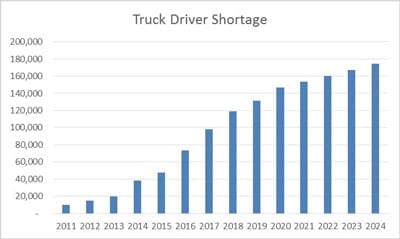OTR Truck Driver Shortage
March 2, 2017
 A Look at the OTR Driver Shortage
A Look at the OTR Driver Shortage
In the course of recent years, the trucking business has periodically battled a driver shortage. The primary deficiency numbers were documented in a 2005 report. At that time, the deficit was about 20,000, and by 2014 it was up to 38,000. There are numerous causes behind this, yet one of the biggest components is the generally high average age of the current workforce. The current average driver age in the OTR industry is 49. Also, this industry struggles to attract all segments of the population. Only 5.8 percent of truck drivers are women. The impacts of the driver deficiency can be felt all through the economy, as 68.9 percent of all cargo tonnage travels the nation’s roadways.
What’s going on?
If the present pattern holds, the deficiency may rise to 175,000 by 2024.
The truck driver shorter appears to be much more challenging to transporters than the ebb-and-flow figures suggest as a result of a quality-versus-amount issue. Numerous transporters have strict hiring criteria in view of driving history, experience and different variables.
Throughout the coming decade, the trucking business should hire an aggregate 890,000 new drivers, or an average of 89,000 every year. By a long shot, replacing resigning truck drivers will be the biggest variable.
Consider Class 8. This is the place the bulk of the truck driver deficiency is hidden. Indeed, even inside this class, by far most of the deficiency is inside the OTR, or non-local, for-contract truckload sector. If the trend goes on for the next decade, there will probably be serious supply-chain disturbances, bringing about huge shipping delays, higher stock conveying costs and perhaps impacts at the store-shelf level.
Quality is always important rather than quantity. The deficiency likely feels much worse to most trucking organizations in light of hiring guidelines. With numerous organizations tracking safety, many generally qualified candidates are excluded for their poor driving history or other related issues. Furthermore, for organizations that are not self-guaranteed, insurance agencies require drivers to have a few years of driving background before they will endorse them. Over the past few years, for-hire truckload driver turnover rates have been more than 90 percent. As indicated by ATA’s 2014 Driver Compensation Study, around half of for-hire truckload transporters offered a sign-on reward with the middle bonus around $1,500.
What to do?
There are numerous reasons for the OTR trucker shortage. These steps below can help decrease the driver shortage.
Driver’s salary increase: We know prices are high when product is short in the marketplace. The same theory applies in over-the-road industry. Drivers’ wages are not increasing, thus decreasing the driver total in this industry. In 2014, the pay was starting to increase, but slid in 2015. If wages continue to rise, the shortage will decrease too. A decent gauge is $35,000 in first year, and $45,000 to $55,000 from that point.
More personal time: Potential drivers always feel hesitation to take a job in the OTR industry. This job requires a lot time away from home, especially at the beginning. To reduce the driver shortage, length-of-haul may have to reduce to increase time at home.
Resetting the driving age: The minimum age for driver candidates is 21. But, eighteen to twenty-year-olds have the highest rate of unemployment in this era. They can’t drive in this industry, so they’re likely to select alternative careers and skip the OTR industry. It may be time to change the driving age to get this new potential driver.
Better treatment at the shipper/receiver: OTR can be a hard lifestyle. Drivers often commit to 300 days per year on the road. Unfortunately, they often get mistreated at shipping and receiving facilities – for example, restricted access to restrooms before the trailer is loaded or unloaded. Improving these experiences will help to retain current drivers and attract more to join the industry.
About Scale Funding
Scale Funding is an invoice factoring company serving businesses across the United States. For more information on factoring, call (800) 707-4845 for a free, no-obligation consultation and quote.


